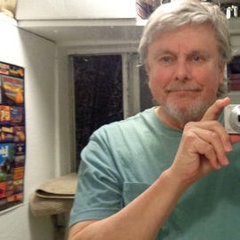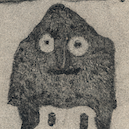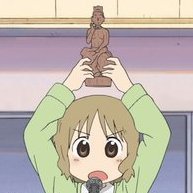-
Content count
2,739 -
Joined
-
Last visited
-
Days Won
8
About Mark Foote
-
Rank
Plum Cuckoo
Recent Profile Visitors
14,112 profile views
-

Is 'just sitting' a post-enlightment practice?
Mark Foote replied to Vajra Fist's topic in Buddhist Discussion
Gautama spoke of cessation, in the context of thoughts initial and sustained with regard to the state of mind: (One) makes up one’s mind: Contemplating impermanence I shall breathe in. Contemplating impermanence I shall breathe out. Contemplating dispassion I shall breathe in. Contemplating dispassion I shall breathe out. Contemplating cessation I shall breathe in. Contemplating cessation I shall breathe out. Contemplating renunciation I shall breathe in. Contemplating renunciation I shall breathe out. (SN V 312, Pali Text Society Vol V p 275-276; tr. F. L. Woodward; masculine pronouns replaced, re-paragraphed) The thoughts he described, he said were a part of his way of living. "Contemplating cessation"--the cessation of the "activities", which are the actions of speech, body, and mind that take place as a result of "determinate thought": …I have seen that the ceasing of the activities is gradual. When one has attained the first trance [first meditative state], speech has ceased. When one has attained the second trance, thought initial and sustained has ceased. When one has attained the third trance, zest has ceased. When one has attained the fourth trance, inbreathing and outbreathing have ceased. ... Both perception and feeling have ceased when one has attained the cessation of perception and feeling. (SN IV 217, Vol IV p 146) I'm convinced Gautama touched on "the cessation of inbreathing and outbreathing" as a regular part of his way of living, that he sat until he attained such a cessation and the subsequent "survey-sign of the concentration", and that by means of the "survey-sign" he could touch on "the cessation of inbreathing and outbreathing" in his contemplation of cessation in daily living. But say--what did you mean by cessation? -
That works, although it's a tad more person to person than a heart to indicate a love of what was written. You're so welcome! If you're interested, there are some amazing photos of Clear Lake and Mount Konocti, here (and some duds, lots of duds, actually, but what's good is very good)--if you're not on Facebook, just click the "x" in the upper right-hand corner of the "See More on Facebook" pop-up.
-
with Issa's blessings the cat goes out, comes back in the doorman gets pissed
-
I've never found that to be true.
-
This. This right here might be at the core of a majority of vexation with regards to the topic. For individuals who have not personally experienced a significant enough decoupling of the societally enforced equivalency of the two, i guess i can see how it might be inconceivable that such a thing even exists. Dao Bums needs a "heart" icon. Lacking which, I give you a quasi-mystical photo of the lake and mountain I live next to, in appreciation. (photo by Stephanie Espinosa)
-
I'm completely fooled, Nungali!
-
Apech, on the left...
-
There are a lot of folks who swear by "pure awareness" as the essential element of sentient being. Something like that. I think of Nisargadatta: My Guru ordered me to attend to the sense 'I am' and to give attention to nothing else. I just obeyed. I did not follow any particular course of breathing, or meditation, or study of scriptures. Whatever happened, I would turn away my attention from it and remain with the sense 'I am'. It may look too simple, even crude. My only reason for doing it was that my Guru told me so. Yet it worked! ("I Am That", Chapter 75, p. 375) 'You are not your body, but you are the consciousness in the body, because of which you have the awareness of 'I am'. It is without words, just pure beingness. Meditation means you have to hold consciousness by itself. The consciousness should give attention to itself. (Gaitonde, Mohan (2017). Self - Love: The Original Dream (Shri Nisargadatta Maharaj's Direct Pointers to Reality). Mumbai: Zen Publications. ISBN 978-9385902833) Or Dogen: Therefore, …take the backward step of turning the light and shining it back. (Eihei Dogen, “Fukan zazengi” Tenpuku version, trans. Carl Bielefeldt, “Dogen’s Manuals of Zen Meditation”, pg 176) I used to write about the location of awareness, but a friend of mine felt that awareness is all encompassing, throughout the universe. Because of him, I switched to writing about the placement of attention, but there's a trick (isn't there always!)--the placement of attention out of necessity in the movement of breath, with the activity of the body following entirely from the location of awareness, such as occurs in the moment before falling asleep. As a matter of daily life, just to touch on such experience, as occasion demands--that's enough.
-
"Pretenders", more so Made me look up the lyrics Fabulous, of course
-
The cat says, make it stop!
-
I can understand that Maddie did not see any point in continuing a conversation with Salvijus. Salvijus, I would suggest that offering personal experience would be more conducive to advancing a practice than debating angels or devils on the heads of pins. Feelings are complex, my feelings on the topic are complex. Maddie has offered a chance to dive into that.
-
My favorite band, in the '80's:
-
Salvijus--keep this in mind: Being intersex is a naturally occurring variation in humans, and it isn’t a medical problem — therefore, medical interventions (like surgeries or hormone therapy) on children usually aren’t medically necessary. Being intersex is also more common than most people realize. It’s hard to know exactly how many people are intersex, but estimates suggest that about 1-2 in 100 people born in the U.S. are intersex. There are many different ways someone can be intersex. Some intersex people have genitals or internal sex organs that fall outside the male/female categories — such as a person with both ovarian and testicular tissues. Other intersex people have combinations of chromosomes that are different than XY ( usually associated with male) and XX (usually associated with female), like XXY. And some people are born with external genitals that fall into the typical male/female categories, but their internal organs or hormones don’t. (https://www.plannedparenthood.org/learn/gender-identity/sex-gender-identity/whats-intersex)
-
It's complicated. There was a study done on why poor people living on welfare in the USA would vote for politicians who declared flat-out that they were going to end those welfare benefits. The answer turned out to be the fear in those same poor people of becoming the racial minority in their state, and the politicians who promised to cut off welfare were also the politicians who promised to keep down the minority. I guess I can understand the fear that's at work there. Just look at what the racial majority did to the racial minority in some states, and you can see why the majority would fear becoming the minority!






_YamiBakuraPicsImagesScreencapsandScans.thumb.jpeg.9045a4d7b9219561c2baf9bde301e522.jpeg)











